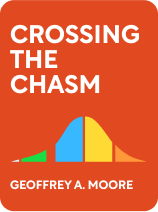

This article is an excerpt from the Shortform book guide to "Crossing the Chasm" by Geoffrey Moore. Shortform has the world's best summaries and analyses of books you should be reading.
Like this article? Sign up for a free trial here .
What exactly is a distribution channel? What are some things you should consider when choosing a distribution channel strategy for your business?
A “distribution channel” is what you use to distribute products to your customers. Different distribution channels are better able to reach different types of customers.
In this article, we will discuss how to choose the most effective distribution channels for reaching your target customers.
Use Your Customer Profile
Moore insists that setting up distribution should be your top priority, above profits, publicity, or even customer satisfaction. He argues that deficiencies in these other things can be remedied, but without a viable distribution channel strategy, you won’t be able to cross the chasm.
(Shortform note: In contrast, McKenna asserts that positioning is the most important thing, presumably regardless of whether you’re in the chasm or not. He points out that if nobody wants to buy your product anyway, then a distribution channel that can reach your customers doesn’t help you.)
At one point, Moore also says you only get one shot at setting up distribution, but later advises that sometimes you may need a secondary distribution channel, implicitly recanting this assertion. Nevertheless, we may infer that selecting an effective distribution method up front is of great importance when crossing the chasm.
Moore advises that different types of customers can more easily be reached through different distribution channels. He identifies five different types of customers based on job titles: engineers, enterprise executives, department managers, small-business owner-operators, and end users. (These are not to be confused with the five psychographic categories of the TALC, since all of these customers should be part of the early majority.) Moore then recommends a method of distributing to each.
(Shortform note: In The Psychology of Selling, Brian Tracy identifies six types of customers, based on their psychological profiles rather than job titles: the reluctant customer, the certain customer, the analytical customer, the relationship customer, the directive customer, and the social customer. Of the six, Tracy’s “reluctant customers” and “certain customers” seem to correlate to the “laggards” and “early adopters” of the TALC, respectively. Based on Tracy’s descriptions of the remaining four categories, there is probably significant overlap between them and Moore’s job-based categories. We will discuss this overlap for each category.)
Engineers
As Moore explains, engineers usually don’t have corporate purchasing authority themselves, but if a company’s engineers decide to use your product as a component of a product they are designing, it could result in a long-term multi-million-dollar contract supplying products to their company. This makes them potentially your most lucrative type of customer, in terms of value per sales contract.
Thus, if your target customer scenario involves engineers integrating your product into theirs, Moore recommends a two-phased distribution channel:
First, you make your product specifications available online where engineers can find them. As you present this information, Moore advises sticking to the facts, as engineers don’t respond well to promotional marketing.
(Shortform note: Moore is not the only one to observe this. Allison Woodbury of Precision Marketing Group blogs that to sell to engineers you have to take a direct, brutally honest approach, presenting detailed information, and avoiding any claims that you can’t objectively substantiate.)
Second, once the engineers express interest, you send salespeople to their company to demonstrate your product, provide samples, or facilitate testing. If the engineers are satisfied, then they can connect your salespeople to their purchasing department to negotiate the sales contract.
| Engineers and Analytical Customers One of Tracy’s categories is the “analytical customer,” who loves details and insists that you prove all your claims, as they move slowly toward a buying decision. This is sufficiently similar to Moore’s description of engineers that we can infer there is significant overlap between engineer customers and analytical customers.Tracy advises you to be patient with analytical customers and thoroughly answer all of their questions. This advice would apply to Moore’s scenario of selling to engineers as well. Indeed, sending people to demonstrate your product and facilitate testing, as Moore advises, would be one way to accomplish this. |
Enterprise Executives
As Moore points out, corporate executives can be lucrative customers because they are capable of making purchasing decisions for entire companies: He estimates their sales contracts are typically worth hundreds of thousands to millions of dollars.
According to Moore, the best distribution channel for reaching high-level executives is “relationship marketing.” Your senior staff connect with customer executives at leadership conferences and develop a consultant-like relationship with them, allowing you to show them how your whole-product solution will meet their company’s needs.
| Executives and Relationship Customers Moore’s enterprise executives could potentially overlap several of Tracy’s categories, depending on the individual executive’s personality. In the case of an early-majority executive, arguably the largest overlap would be with the “Relationship Customer.” Tracy describes the relationship customer as someone who values her reputation and needs to develop a relationship with you before committing to purchase. These qualities coincide with Moore’s characterization of the early majority and his recommendation to use relationship marketing. Tracy advises taking your time with relationship customers, and asking lots of questions. He also recommends talking about other customers who’ve been happy with your product. Again, this agrees well with Moore’s advice to develop a consultant-like reputation with executives. |
Department Managers
If your target customer is more likely to be a department manager than a corporate executive, Moore advises using a “Sales 2.0” distribution channel, which combines digital marketing with human marketing—when a prospective customer visits a website and clicks on a link, they’re directed to a human representative instead of an automated service. The human rep, however, is online as well, so that the whole experience is digital.
Moore notes that department managers can only make department-wide purchases, so their orders tend to be smaller than those of executives, which is why he recommends a Sales 2.0 approach—it’s a cost-effective way to manage a larger number of sales contracts from initial inquiry through final sale and ongoing support.
(Shortform note: The term “Sales 2.0” was coined by Nigel Edelshain, CEO of a company by the same name that trains sales people. He developed the “Sales 2.0” approach in recognition of the fact that the era of cold-calling, where a salesperson essentially interrupts a prospective customer to ask for a sale, is coming to an end.)
| Department Managers and Social Customers Moore’s department managers could potentially overlap several of Tracy’s categories, depending on the individual manager’s personality. However, Tracy identifies “Social Customers” as being social, extraverted, and often in a position that requires coordinating teams of people, such as a project manager or a business executive. As such, this category arguably offers the largest overlap with Moore’s department managers. Tracy asserts that social customers are prone to forgetting that they agreed to purchase your product, and thus advises you to get their purchase agreements in writing immediately. While Moore makes no such allegations about department managers, using a “Sales 2.0” system as Moore recommends would provide a record of communications that would document the customer’s purchase decision automatically. |
| Sales 2.0 versus Sales 2.1 Since Moore originally wrote Crossing the Chasm, relationship marketing and “Sales 2.0” have arguably merged into a single tactic. On the one hand, relationships are increasingly maintained through social media and electronic communications. On the other hand, CRM (Customer Relationship Management) software has become so prolific, and provides such a powerful resource for keeping track of individual customers’ needs, preferences, purchase history, and so on that even automated communications can be highly personalized. Thus, the greater integration of software into relationship marketing methods and the greater efficiency of personalized communication with customers that software now facilitates have blurred the distinction between the two. Some analysts are referring to the new integrated sales tactic as “Sales 2.1”. |
Small-Business Owner-Operators
If your target customer is likely to be the proprietor of a small business, Moore recommends using Value-Added Resellers (VARs) as your product distribution channel.
Moore describes the typical VAR as a local technology enthusiast who makes a living by assembling high-tech whole products for his less tech-savvy neighbors and providing technical support. He further asserts that the typical small business owner needs high-value solutions and is not very tech-savvy, making him a natural customer for the VAR.
(Shortform note: Moore is not the only one to make these assertions. Small business marketing bloggers like John Jantsch attest that small business owners usually need a sales channel that can educate them on both why the product is useful and how to implement it effectively, provide prompt, personalized service, and continue to support them long term. While Jantsch doesn’t mention VARs per se, it is easy to see how a local technology-enthusiast VAR such as Moore describes would be in a good position to meet these demands.)
| Small Business Proprietors and Directive Customers Moore’s small-business owner-operators could potentially overlap several of Tracy’s categories, depending on the individual’s personality. However, the most probable overlap would arguably be with Tracy’s “Directive Customers.” Tracy characterizes directive customers as busy, businesslike people who want to understand the practical benefits your product can provide, but aren’t interested in developing an ongoing relationship with your company. When dealing with them, he advises dispensing with small talk and showing them the bottom line up front. Moore highlights small business’s tight budgets, which could promote the abrupt, businesslike attitude of directive customers, and if they buy your product from a VAR instead of dealing with you directly, that implies they don’t care about developing a relationship with you. |
End Users
If your target customer is likely to be an end user capable of making only low-cost purchases for himself or his immediate work-group, Moore identifies web-based self-service as the preferred distribution channel, with email, banner ads, or other forms of promotional advertising to raise awareness of your product and provide links to your website. He remarks that targeted advertising is making it easier and easier to reach your specific target customers with this method.
(Shortform note: In 2013, a study reported that the average advertising cost of getting a prospective customer to click on a link was $0.72 per click with traditional mass advertising, but only $0.16 per click with targeted advertising. This statistic helps to quantify just how much easier targeted advertising makes it to reach your target customers.)
Moore explains that in this case, your objective is to keep costs down by minimizing personal interaction with customers. He also asserts that with attention to web design, self-service can provide a better customer experience than dealing with salespeople. He suggests integrating FAQs and community-based help forums into your web service to minimize the burden of product support.
| End Users and Directive Customers Of Tracy’s six categories of customers, the only one that doesn’t rely on a relationship with the salesperson is the “Directive Customer.” As we discussed in the context of small business proprietors, directive customers are businesslike and benefits-focused. They want to understand how the product meets their needs, but they don’t want to interact with salespeople any more than necessary. Thus, when Moore recommends web-based self-service as a distribution channel to sell products to end users with a minimum of human contact, he implies that the end users tend to be directive customers. Tracy estimates that directive customers, analytical customers, social customers, and relationship customers each make up about 25% of the population. Since end users tend to comprise a larger fraction of the population than executives or other job-title categories, this begs the question: Are end users disproportionately directive customers? Or is web-based self-service only effective at reaching about 25% of end users, while a more personal approach could reach the other 75%? In the latter case, it may not be practical to reach out to the other 75% at this time, because of the low profit per sale to end users, and the time required to build a relationship with a customer. However, as AI (artificial intelligence) becomes more sophisticated and more prolific, this may change in the near future. Companies are already using AI “chatbots” as force-multipliers for their sales force. Perhaps it won’t be long before AIs become capable of developing convincing customer relationships, and begin to blur the distinction between web-based self-service and relationship-based marketing. |
Price Your Product to Sell
Once you’ve selected a distribution channel that can reach your target customers effectively, the final element of Moore’s strategy for crossing the chasm is to set your product’s price such that it motivates the distributor to sell your product.
When you’re crossing the chasm with a disruptive innovation, salespeople may initially have to put in some extra work to close sales. Thus, Moore advises building enough profit margin into your product’s retail price that it’s worthwhile for your distributor to go out of their way to sell it.
He also cautions you not to set your price too high or too low. He says your price is too high if it becomes a sticking point with prospective customers. However, he also asserts that early-majority customers expect the market leader to charge up to 30% more than their competitors, because the leading product should give the customer a competitive edge and keep whole-product costs down. Thus, if you are trying to position yourself as the market leader, your pricing should be consistent with your positioning claim.
| Finding the Market Price According to Charles Wheelan, author of Naked Economics, the market price of a product is the price at which supply and demand are in balance. If you set your price too high, the high profit margin per sale gives you incentive to produce products for sale, but people aren’t likely to buy them: High prices create excessive supply and inadequate demand. If you set your price too low, everyone will want to buy one, but there’s little incentive to produce or distribute the product: Low prices generate excessive demand and inadequate supply. Thus, as Wheelan explains, companies tend to adjust their prices until supply and demand are equal: The profit margin is just high enough to motivate the producer (and distributors) to make and sell the quantity of products that people want to buy at that price. At this point, the market price has been reached. Wheelan’s explanation is consistent with Moore’s recommendation not to set your price too high. However, if you set your price too low, Wheeler’s simple supply-and-demand model predicts that everyone will want it, while Moore asserts that the early majority won’t want it at all, because your low price undermines your claim of being the market leader. |

———End of Preview———
Like what you just read? Read the rest of the world's best book summary and analysis of Geoffrey Moore's "Crossing the Chasm" at Shortform .
Here's what you'll find in our full Crossing the Chasm summary :
- An explanation of the chasm phenomenon that many new high-tech products face
- How to pilot a product across this chasm to mainstream success
- The problems with the Technology Adoption Life Cycle (TALC) model






